Investors and speculators are always looking for an edge in determining the strength and direction of trends. The Heikin Ashi application is one tool that may be able to provide this edge. Similar to the Ichimoku charts, the Heikin Ashi has been a relatively unknown tool that has recently seen a rise in popularity, even though it has been accessible since its introduction almost two decades ago.
In addition to showing the relative strength of a trend, the application also notes key turning points in price action and reacts much like a moving average. Incorporating the overall session activity in a single candlestick (open, close, high and low), the charting tool also "smooths" over erratic fluctuations in the currency markets and omits spikes that may be sparked by volatility or jumps in price. This allows chartists to obtain a clearer picture of what's going on in the market and to make a more informed trading decision. Let's take a look at how the Heikin Ashi is calculated and how it can be applied to forex trading.
Defining the Heikin Ashi
Before we get into the actual application of the Heikin Ashi, let's dive into some logistics involving the real meaning behind it. Usually a type of candlestick chart, the Heikin Ashi is available on some charting packages as a separate indicator. This allows investors or speculators to make a side-to-side comparison between the standard candlestick and the Heikin Ashi, allowing for a more cohesive interpretation. In Figure 1, the chartist can see that the two are very similar but offer different perspectives, as the Heikin Ashi indicator disregards market noise and concentrates on the smoother trend of the underlying price action in the euro/U.S. dollar.
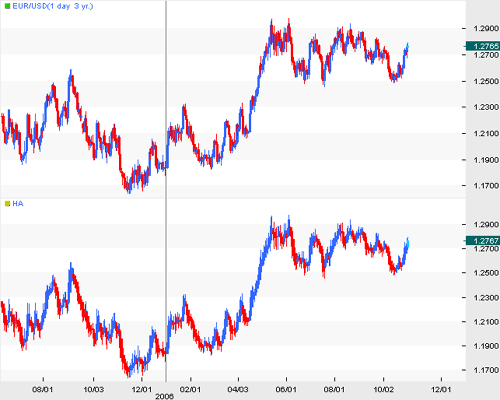 |
| Source: FX Trek Intellicharts |
| Figure 1: A nearly identical interpretation (top: price action, bottom: Heikin Ashi) |
The reason the Heikin Ashi tends to be smoother is because instead of using a simple low and high of the session to calculate individual candles, the Heikin Ashi takes the prices per bar and averages them to create a "smoother" session. This is key because the currency markets tend to offer traders more volatility and market noise in the price than other markets. Here is how each candle is constructed:
- Close = (Open Price + High + Low +Close) / 4
- Open = (Open Price of the previous bar + Close Price of the previous bar) / 2
- High = [Maximum value of the (High, Open, Close)]
- Low = [Minimum value of the (Low, Open, Close)]
By plugging formulas into each individual session to construct consecutive candles, the chart continues to be reflective of the underlying price action, isolating the price and excluding currency market volatility and noise. The resulting picture gives the trader a more visually appealing perspective, and one that can help in identifying the overall trend.
Now that we've established how the candles are calculated, here is how to interpret them:- Positive candles (blue) containing no wicks: There is strong uptrend momentum in the session and it will likely continue. Here, the trader will have a hands-off approach to profits while strongly considering adding on to the position.
- Positive candles (blue) containing shadows or wicks: Strength continues to support the price action higher. At this point, with upside potential still present, the investor will likely consider the notion of adding to the overall position.
- A smaller candle body with longer wicks: Similar to the doji candlestick formation, this candle suggests a near-term turnaround in the overall trend. Signaling indecision, market participants are likely to wait for further directional bias before pushing the market one way or the other. Traders following on the signal will likely prefer confirmation before initiating any positions.
- Negative candles (red) containing shadows or wicks: Weakness or negative momentum is supporting the price action lower in the market. As a result, traders will want to begin exiting initial long positions or selling positions at this point.
- Negative candles (red) containing no shadows or wicks: Selling momentum is strong and will likely support a move lower in the overall decline. As a result, the trader would do well to add to existing short holdings.
The Heikin Ashi will still take some time to master; however, once this is accomplished, the Heikin Ashi will act to confirm the overall trend of the price action. Now let's see how it is used in market opportunities.
Improve on Opportunities
With a smoother picture, sometimes a more simplified one, a speculator can improve on trading the overall trend by combining the Heikin Ashi with multiple indicators. As with any other chart application, it's better to find an indicator that works well with your individual trading style when adding on the Heikin application. This will not only help traders to establish a directional bias, but it will also clear up entries, support and resistance and offer further confirmation of the trade becoming profitable. In Figure 2, the chartist is looking at a prime example using the Australian dollar/Canadian dollar currency pair.
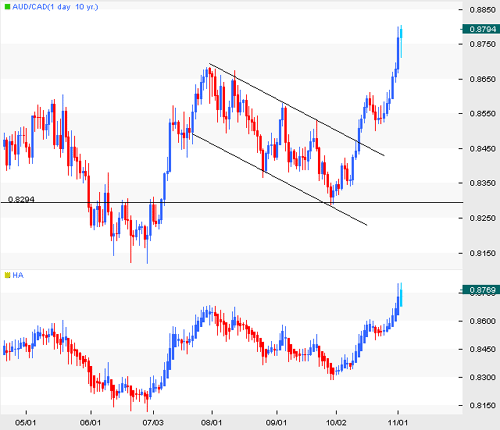 |
| Source: FX Trek Intellicharts |
| Figure 2: A pivotal turn confirmed by Heikin Ashi |
Taking a look at the price action, the Australian dollar weakened enormously against a rising Canadian dollar, hence the downtrending channel. Reaching the psychological 0.8300 support, the cross pair presents an opportunity to the speculator. Not only is the AUD/CAD pair testing the support trendline at the 0.8300 level, the potential bottom coincides with the lower channel trendline. Confirming the strength of such a barrier, we overlay the Heikin Ashi and focus on the two dojis that have formed on the chart. The presented signal gives us the best confirmation in this example, as the trade is calling out a long position in Figure 3.
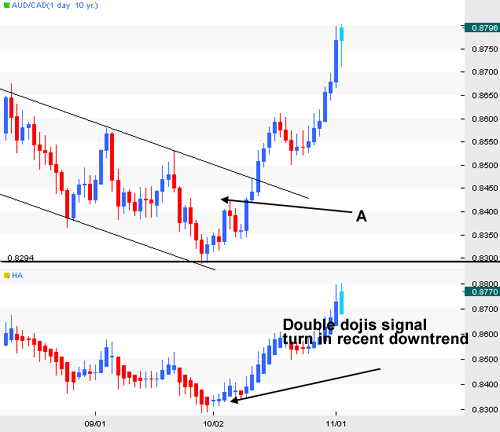 |
| Source: FX Trek Intellicharts |
| Figure 3: Two dojis scream out a probably long Signaling a potential turn in the price action, the dojis set the trade up nicely. Next, an entry point must be established. At this point, the best entry afforded, according to industry theory, is a break above the high of the session at Point A in Figure 3. This will set the long buy order at 0.8400 with a corresponding stop 2 points, for example, below the low of the session, at 0.8328. Theoretically, the trade is looking to profit, not only on a retracement test of the upper trendline, but a potential break. That's where the profits lie as the break above would create a longer term advance. The idea coincides with what is being viewed on the Heikin Ashi. Over the course of the next month, with the stop fully intact and untriggered as the price never trades back, the long position remains profitable until the creation of another doji near mid month's time. Taking into account the close of the session - including the doji, which is precisely set at 0.8554 - the trade has already profited by 154 points. Looking back, this is more than sufficient, as the risk/reward ratio is well above the 2:1 minimum prescribed. Subsequently, a trailing stop would be perfect at keeping profits close while letting potential unfold in the coming weeks. Breaking It Down Let's take it down a notch and look into the steps of another example. Here, we'll reference a textbook example in the New Zealand dollar/Japanese yen currency pair. Taking a look at the overall price action, we see consolidation in the month of July on the longer term daily chart. Applying the stochastic oscillator, we see a golden cross form (Point B), suggesting a near-term uptick in Figure 4. |
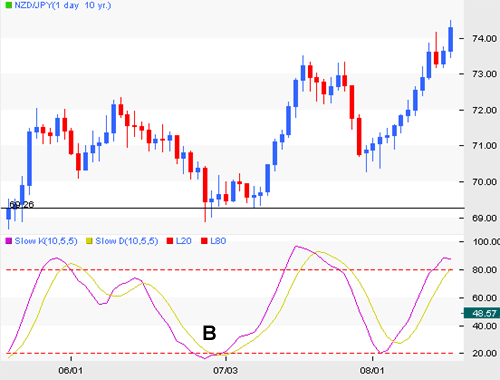 |
| Source: FX Trek Intellicharts |
| Figure 4: Point B shows trigger on golden cross |
- Identify support or resistance: Although not a full requirement, this helps to establish a viewpoint where a directional bias can be established. This will likely help in isolating points of entry, assisting with stop placement and risk assessment. In the example, there is ample support that is coming in at the 69.25 figure, offering a great opportunity for a long trade.
- Overlay the technical indicator: The stochastic oscillator assists in suggesting bidding support as both indicators begin to form a golden cross. The cross at Point B confirms the trade bias and isolates the point of entry.
- Confirm with Heikin Ashi: Obtaining the entry point off of support and the technically bullish crossover in the stochastic, the trader can confirm the strength of the nascent trend by using the smoother based candles. In the visual example at Point C, the chartist can see that the doji is indicative of the shift in momentum as sellers begin to exit the market. Simultaneously, the following longer bodied candle signifies a stronger uptrend in buying.
- Place Entry Order: Now, with the directional bias confirmed, the trader will do well to place the entry five to 10 points above the doji session high. Although the order can actually be placed at the high or any other position in the session, the placement in this case is in order to capitalize on a breakout of price action (Point D). As a result, the entry is placed at 69.90. Placing the corresponding stop five points below the support will ensure a viable test. Should the level be broken to the downside, the previous trade is negated on overriding selling momentum. However, in this case, our indicators confirmed the directional bias, profiting 360 points before topping out for the first time two weeks.
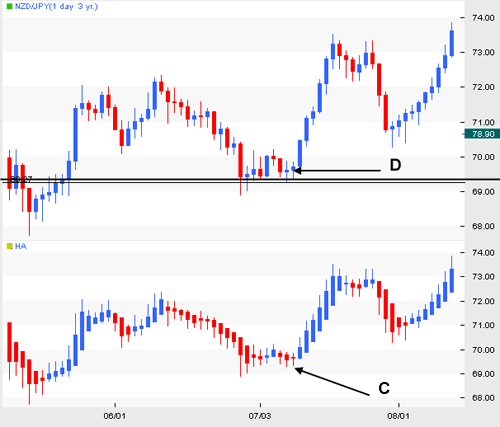 |
| Source: FX Trek Intellicharts |
| Figure 5: Point B shows trigger on golden cross |


















